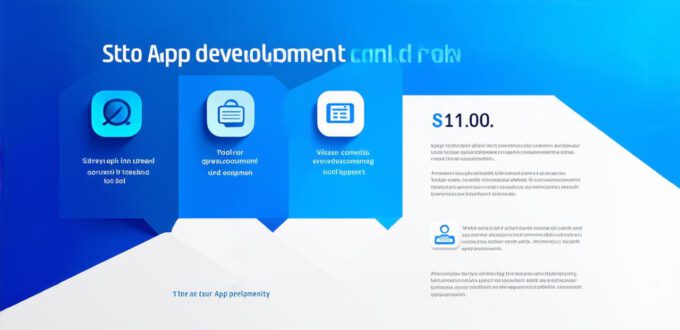<div>
<h2>Introduction</h2>
<p>In today's digital age, mobile apps have become an integral part of our daily lives. As a result, app development has become a lucrative industry, and it is essential for developers to present their ideas effectively to secure funding, investors, and clients. However, creating a successful app development presentation can be challenging, especially for those who are new to the field. In this article, we will provide a comprehensive guide on how to create an engaging and informative presentation that will resonate with your target audience of app developers.</p>
<h2>I. Understanding Your Audience</h2>
<p>Before you start creating your app development presentation, it is crucial to understand your audience. Who are you presenting to? Are they investors, clients, or fellow developers? What are their expectations, and what do they hope to gain from the presentation? By answering these questions, you can tailor your presentation to meet their specific needs and preferences.</p>
<h2>Case Study: Apple's App Store Launch Presentation</h2>
<p>Apple's launch of the App Store in 2008 is a great example of how to create a successful app development presentation. The company invited journalists, bloggers, and tech enthusiasts to attend the event at the Moscone Center in San Francisco. Apple's CEO Steve Jobs started the presentation by introducing the concept of mobile apps and their potential to change the way people interact with technology. He then demonstrated some of the first apps available on the App Store, including games, productivity tools, and social networking apps.</p>
<p>Jobs used a simple yet effective approach to engage his audience. He told stories about how these apps would improve people's lives and make them more productive and connected. He also showcased the apps in action, allowing the audience to see their benefits firsthand. By focusing on the impact of the apps, Jobs was able to create a sense of excitement and anticipation around the launch of the App Store.</p>
<h2>II. Developing Your Presentation Structure</h2>
<p>Once you have a good understanding of your audience, it's time to start developing your presentation structure. A well-structured presentation will help keep your audience engaged and focused on the main points.</p>
<ol>
<li><p>Start with a strong opening</p></li>
<li><p>Use headings and subheadings</p></li>
<li><p>Include visuals</p></li>
<li><p>Focus on the benefits</p></li>
<li><p>Close with a strong conclusion</p></li>
</ol>
<h2>III. Crafting Your Presentation Narrative</h2>
<p>A successful app development presentation requires a compelling narrative that captures your audience's attention and keeps them engaged throughout.</p>
<ol start="3">
<li><p>Tell a story</p></li>
<li><p>Use analogies and metaphors</p></li>
<li><p>Create a sense of urgency</p></li>
<li><p>Be authentic and genuine</p></li>
</ol>
<h2>Case Study: Uber's Presentation at TechCrunch Disrupt</h2>
<p>Uber's presentation at TechCrunch Disrupt in 2010 is a great example of how to craft an effective app development narrative. The company's founders, Travis Kalanick and Garrett Camp, started by telling their story about how they came up with the idea for Uber while living in San Francisco. They discussed the challenges they faced, such as long wait times and high costs for taxi rides, and how their app would solve these problems.</p>
<p>Kalanick and Camp then showcased the Uber app in action, allowing the audience to see how it worked and the benefits it provided. They also highlighted some of the key features that set Uber apart from traditional taxi services, such as real-time tracking and payment processing.</p>
<h2>IV. Incorporating Research and Experiments</h2>
<p>To demonstrate the effectiveness of your app idea, it's essential to incorporate research and experiments into your presentation. This will help you validate your assumptions and show that your app has real-world potential.</p>
<ol start="4">
<li><p>Use case studies</p></li>
<li><p>Conduct experiments</p></li>
<li><p>Use data and analytics</p></li>
</ol>
<h2>Case Study: Dropbox's Presentation at TechCrunch Disrupt</h2>
<p>Dropbox's presentation at TechCrunch Disrupt in 2008 is a great example of how to incorporate research and experiments into an app development presentation. The company's founders, Drew Houston and Arash Ferdowsi, started by discussing their research on the challenges people faced with file sharing and collaboration.</p>
<p>They then demonstrated the Dropbox app in action, allowing the audience to see how it worked and the benefits it provided. Houston and Ferdowsi also conducted experiments to validate their assumptions about user behavior, such as testing different file sizes and formats to determine what worked best for users.</p>
<h2>V. Conclusion</h2>
<p>A successful app development presentation requires a compelling narrative, effective use of visuals, and clear communication of benefits. By following these tips and incorporating research and experiments into your presentation, you can create a compelling case for your app idea and increase the likelihood of success. Remember to be authentic, tell a story, and focus on the benefits to capture your audience's attention and leave a lasting impression.</p>
</div>
